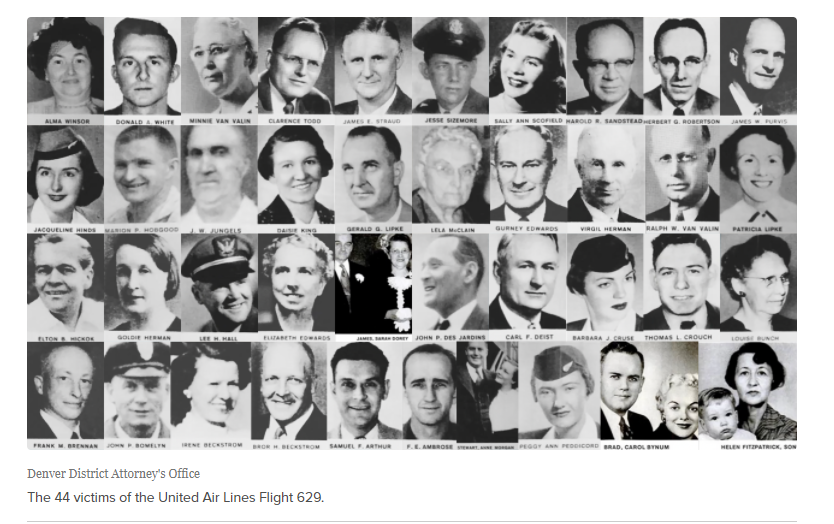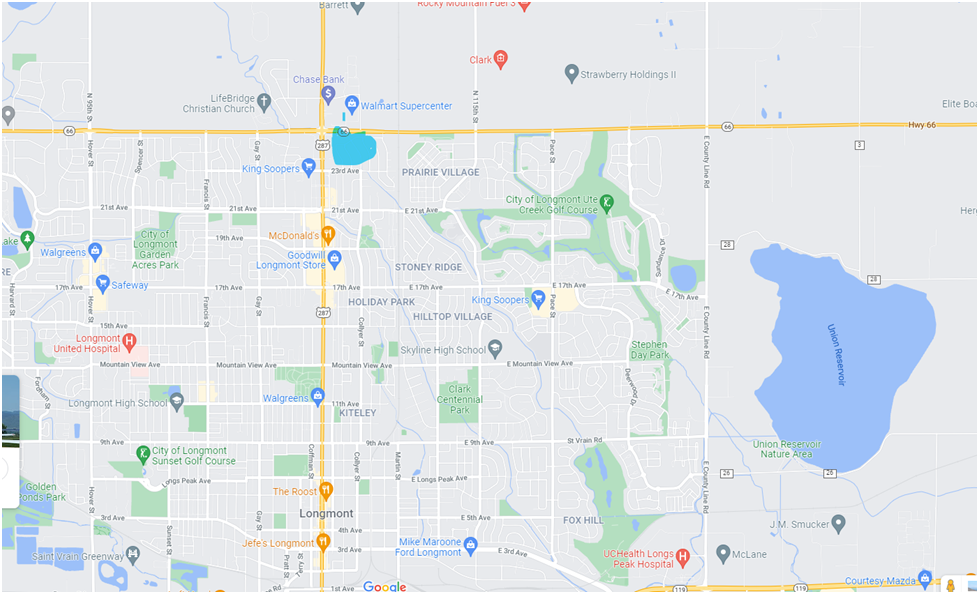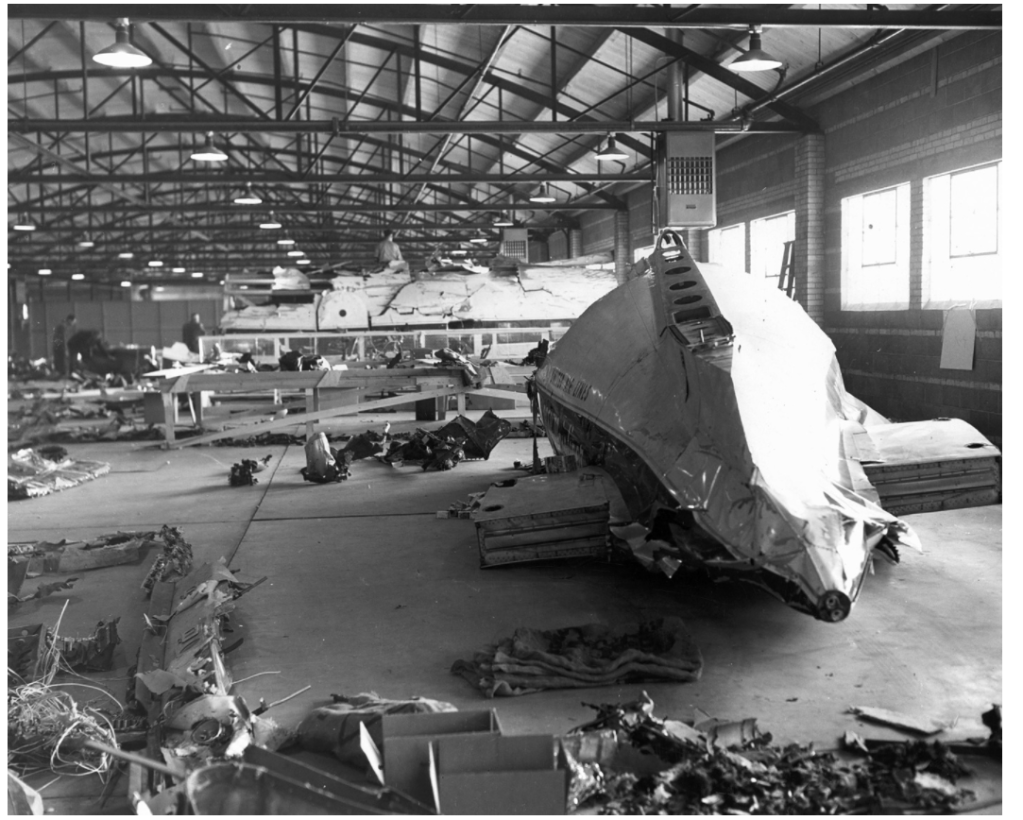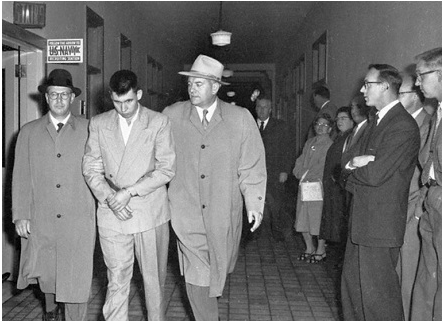
On a cool night on November 1, 1955, the skies over Longmont, Colorado, were aglow with a strangeness. That would grip not only the tiny farming community but also the nation. A bomb blew apart the United Airlines Flight 629, taking thirty-nine passengers and five crew members. The flight originated from Stapleton Airport in Denver, Colorado, to Portland, Oregon. It was only eleven minutes into its flight. The tragedy took many lives and changed many more.
I would like to take some time to first present this case by telling a little about the victims of this tragedy. The passengers and crew were everyday folks just like you or me. Some could have been our close friends or relatives. In fact, there were some people who were taking their very first airplane trip across the country. Others were returning home, or starting new lives somewhere else. There was a mother and infant son traveling to be with a father serving in Japan. The infant boy’s father had only met his son briefly after he was born. We tragically lost all these lives in this horrific incident.


A nation in mourning brought about a pretty amazing timeline of events following the crash. In fact, the FBI was assisting in the investigation the very next day, November 2, 1955.
United Airlines Flight 629 Was National News
The local newspapers, The Denver Post, and Rocky Mountain News were carrying multiple articles on their front pages. The national news stations were also broadcast on TV all across the United States. It was a much different time than we modern folk are accustomed to. News or events back then took time to reach across the nation like days or weeks. Nothing like our instant access to information today.
The Birth ofAirplane Crash Investigations Still Used Today
It was an amazing feat to bring all of these national agencies together. All of them working with local law enforcement. United Airlines personnel and even the plane’s manufacturer, Douglas Aircraft, were bringing new investigative techniques, using new identification methods, and so many other tactics. All before the nation’s eyes. Congress would pass laws within a year after this horrific event. Colorado also saw some of its laws weren’t ready for something of this magnitude. And the state also would enact many changes to its laws because of this tragedy as well.
Side Bar on How Quickly Agencies Came Together
I grew up in a sleepy town in Colorado myself. So, I can relate to the slowness of yesteryear but not everyone can. In farming communities like the one I grew up in, life has a different pace. It can seem there are two rates, slow and slower. Even today, when I am around that area, it is not uncommon to be caught behind a farming tractor. Going down a two-lane highway at only fifteen or twenty miles an hour.
If I am being honest, this affects the choices of roads I travel on at certain times of the year. I have spent too much time in cities where people rush here and there. While I appreciate the hard work of farmers and ranchers, I forget it takes time to do what they do. I hope this gives a smidge of an idea of just how amazing it was.
That so many folks could come together so quickly. And the importance all the people involved with investigating this must have felt. There was clearly a sense of urgency to get answers. Why did this happen? What caused it? What can we as a nation do to avoid this from happening again? And as the investigation answered some of these questions, it raised new questions.
Digging Back Into the Bombing of United Flight 629
Let’s go back to that yesteryear and try our hand at being gumshoes to see what we can find. Our story is more than just a timeline of events. We will start with the crash. Then move on to the investigation and, conclude with some individual history information about the victims and their lives.
 I have highlighted the approximation of the crash site location today in blue. Plane crash site coordinates in Longmont, Colorado 40°12′0.51″N 104°57′21.96″W
I have highlighted the approximation of the crash site location today in blue. Plane crash site coordinates in Longmont, Colorado 40°12′0.51″N 104°57′21.96″W
On November won, 1955, United Airlines flight 629 took off on its flight at 6:52 PM. At approximately 7:03 PM., people saw the first bright light and heard the explosive sounds over Longmont, Colorado. Within only a minute or two, people felt and heard a second explosion. When remnants of the DC-6B fell to the ground on a sugar beet farm near Highway 287 and Highway 66. The local farmer and his two sons rushed to the scene.

Investigation Begins of United Flight 629
The local authorities were called to the area shortly thereafter. Within only a few hours, the searchers organized themselves. Inspected several miles, where they determined the area of wreckage and discovered there was no evidence of survivors. The next morning on November 2, the FBI fingerprint experts arrived from Washington D.C. And joined the Denver Field Office of the FBI, the Civil Aeronautics Board, United Airlines officials, and local law enforcement to begin their investigation. They set a temporary morgue up in Greeley at the National Guard Armory. The FBI started the identification of all passengers. Investigators gathered all the wreckage from the plane. And took it to a large warehouse at Stapleton Airport from November 2 through November 7, 1955.
Four teams went out into the local community and conducted over two hundred interviews with locals and documented them. Each of the four teams of interviewers comprised a Civil Aeronautics Board member, United Airlines official, or employee. Some teams also had help from local law enforcement or a member of the FBI. Of the two hundred interviews, only thirty-seven were of value to the investigation.
Victim Identification With Finger Prints?
 Image of National Guard Armory in Greely from Wikimedia Commons
Image of National Guard Armory in Greely from Wikimedia Commons
In Greeley, the identification of the victims began. The fingerprint experts found that relatives and friends had already been identified and removed from the armory nine people. Passenger’s personal effects made some of the identifications. The FBI used fingerprint analysis from various files to positively identify twenty-one of the remaining thirty-five bodies.
Stop and think about this a second Grim folk. This was 1955, and they had over sixty percent of the victim’s fingerprints on file. I have to shake my head at this. It just seems unreal to me. This alone is pretty amazing, but within forty-eight hours of the crash, they identified every victim.
Pioneering Techniques of Crash Investigation
 Image from https://www.fbi.gov/history/famous-cases/jack-gilbert-graham
Image from https://www.fbi.gov/history/famous-cases/jack-gilbert-graham
In the warehouse, the airplane investigation was no less impressive. This was only the second case of domestic terrorism (our modern term) in US history. The investigators reassembled the plane to help determine what brought it down. This was a new technique then and is still used today to investigate plane crashes. And they managed this in a week! Y’all I have spent that long working on a 3,000-piece jigsaw puzzle. Yeah, for me, this speaks volumes of the investigator’s determination and passion to find answers. Once the plane was reassembled, the investigators determined the explosion had originated in the luggage compartment. Which was in the underbelly of the plane.

So many things happening at once, wow!
On November 7, 1955, the investigation turned to the passengers. Digging into their lives, their families, friends, and business dealings to see who might have planted a bomb on the plane. They left no stones unturned. These officials had a mission. Investigators ultimately ended up interviewing Daisy Walker King’s son Gilbert Graham. Who was ultimately found to be responsible for bringing down flight 629.
The Focus Moves to Jack Gilbert Graham
The FBI file on “Jack” Gilbert Graham goes into great detail about his motivations for making the bomb. His volatile relationship with his mother, his psychological abandonment issues, and his laundry list of previous crimes.
I am only going to briefly summarize these. If anyone would like further details, there will be links to the references at the end of this blog post. I want to focus on other aspects of this case. Having said all of this, let’s get back to our story, shall we?

image from murderpedia.org
When the FBI first interviewed Jack and his wife, they were initially just trying to gather background on his mother. Verifying he and his family had seen her off on her flight from Denver. And what the nature of her trip was. Jack’s answers seemed to differ a bit from his wife’s. This caused a further investigation into his history, and, well, they turned up with more questions.
Jack Gilbert Graham Brought Down United Flight 629
These investigators were sharp. Noted there were some inconsistencies around Jack adding a “gift” to his mom’s luggage. In addition, he purchased a life insurance policy at the airport in which he was the sole beneficiary. The FBI scrutinized Jack and found he had quite the history. So they dug deep and found his criminal history included forgery, theft, and allegations of arson. And reports of domestic violence against his wife, reported by his sister. As well as a potential insurance fraud on a newly purchased truck.

The FBI noted the volatility between mother and son from employees of the restaurant Daisy owned and Jack managed. There were statements they fought like cats and dogs reported in various Rocky Mountain News articles published in November 1955. Eventually, all this ended up with an in-depth questioning of Jack. I found some conflicting information on what exactly led up to his confession. I am going to go with the FBI documentation. Soon after his confession, Jack transferred all his possessions to his wife and sought a public defender from the state. Once the authorities officially arrested him, three lawyers took on his representation.
The Legalities of the Bombing of United Flight 629
The arrest was an item of interest for the state of Colorado. The prosecutors wanted to charge Jack with multiple murders. Something for bringing down the plane, but none of these laws existed. All the state of Colorado could charge Jack with was a single murder for that of his mother, Daisy.
Let this sink in Grim folk, seriously. There is a confession that includes making a bomb out of 25 sticks of dynamite. His motivation was insurance money ($37,500 then which is roughly $354,293 today). He wanted to get his mother out of his life. He understood clearly and acknowledged that in the commission of his mother’s murder, others would die. This man had serious issues, which are unquestionable. I just have the hardest time with the limitation on Jack’s charges. I am questioning if justice was truly served. This case clearly showed the need for change. New laws were desperately necessary to address this level of destruction and tragedy.
Jack, There is no Easy Way Out for You
Jack attempted suicide on February 10, 1956. However, a guard at the Denver Jail foiled his attempt. From this point, they took Jack to four different psychiatrists. He was evaluated at the Colorado State Hospital. To verify if he was mentally sane and competent to stand trial. The court cleared him, and they set the trial to begin on April 16, 1956.
First Televised Trial in Colorado
The judicial system had to face other firsts before the trial could begin. This would be the first televised trial for the state of Colorado. In addition, there were telephone wires to record the audio to be broadcast for immediate coverage by newspapers. In our modern lives, we routinely watch court TV, but this was truly a first for Colorado and the nation. Nineteen days after the trial began, the jury came back with a guilty verdict after only sixty-nine minutes of deliberation. The jury had found Jack guilty of the murder of the first degree, punishable by death.
“Jack’s defense team filed an appeal. Jack took the stand and said he did not wish for a new trial. He also stated he didn’t want his case reviewed by the Supreme Court. His defense team filed the appeal without his consent. The judge sentenced Jack to be put to death the week of August 26, 1956. The day, the hour, and the minute to be selected by the warden of the Colorado State Penitentiary.” This was a direct excerpt from the FBI report on their website.
Again, Jack’s defense lawyers filed another appeal that was later denied. A new execution for the week ending January 12, 1957. They executed Jack in the gas chamber at the Colorado State Penitentiary on Friday, January 11, 1957. Jack died just twelve days before his twenty-fifth birthday. He was cremated and, in a bit of irony, they scattered his ashes around his mother’s grave in Denver.



Thank you for spending time with us today! We have several other true crime stories if you would like. Such as True Crime Lover’s Guide to Forensic DNA or Twisted Trail of Murder.
Sources:
https://www.fbi.gov/history/famous-cases/jack-gilbert-graham
https://www.findagrave.com/virtual-cemetery/507898?page=1#sr-125631387

One response to “High Flying Murder United Flight 629”
Thank you for the reference to our article and research of this horrible crash.